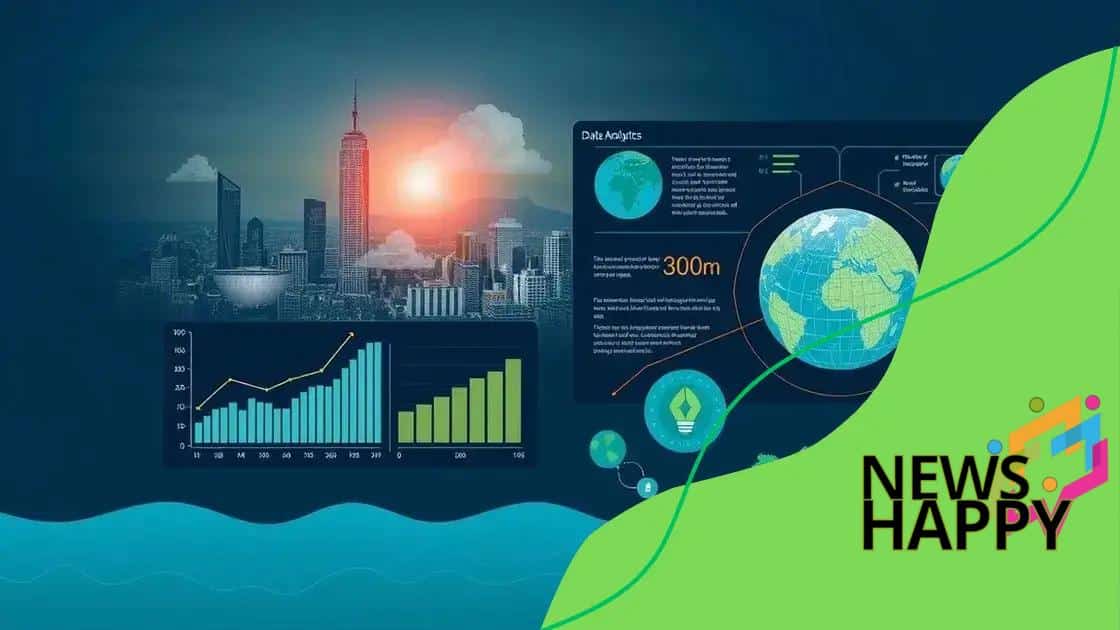The role of data analytics in combating climate change

Anúncios
The role of data analytics in combating climate change is crucial, as it enables organizations to make informed decisions, optimize resources, and track environmental impacts effectively.
The role of data analytics in combating climate change can’t be understated. Have you ever wondered how data shapes climate policies and actions? In this article, we’ll explore the vital contributions of data analytics in tackling this global crisis.
Anúncios
Understanding data analytics and its significance
Understanding data analytics is vital in today’s world, especially when it comes to addressing complex issues like climate change. Utilizing data effectively can lead to informed decisions and innovative solutions. In this section, we’ll explore the significance of data analytics.
What is Data Analytics?
Data analytics involves examining data sets to draw conclusions about the information they contain. It helps organizations understand trends, patterns, and insights that could be crucial in combating climate change.
Importance of Data Analytics
Its importance lies in the ability to:
Anúncios
- Facilitate data-driven decision-making
- Identify potential risks and opportunities
- Enhance operational efficiency
- Support sustainable practices
Furthermore, data analytics enables scientists and policymakers to track environmental changes. By analyzing weather patterns, emissions data, and resource usage, stakeholders can develop targeted strategies to mitigate climate impact.
By integrating data analytics into environmental initiatives, organizations can allocate resources more effectively and measure the success of their programs. For instance, these insights might reveal which strategies are most effective in reducing greenhouse gases or conserving water.
Data analytics helps in creating predictive models. These models can forecast future environmental conditions based on historical data, allowing for proactive measures. For communities facing rising sea levels, analytics can predict which areas will be most affected, guiding community planning and resource allocation.
In summary, understanding data analytics and its significance is crucial for effective climate action. As we delve deeper into this topic, we will uncover more ways that data can drive positive change for our planet.
How data analytics drives climate action
How data analytics drives climate action is a crucial topic as we face environmental challenges today. By harnessing data insights, organizations can implement effective strategies to combat climate change.
Identifying Key Areas for Action
Data analytics helps identify the most critical areas for climate action. Through analyzing emissions data, we can pinpoint sources of pollution. This allows for targeted interventions, ensuring that resources are focused where they can make a significant impact.
Enhancing Policy Development
Another vital role of data analytics is in shaping policies. By providing evidence-based insights, data supports the creation of effective environmental regulations. For example, data can help assess the impact of carbon taxes or emission reduction goals.
- Supports transparent decision-making
- Informs stakeholder engagement
- Drives public awareness campaigns
Moreover, real-time data analytics can monitor the impacts of environmental policies. This ongoing assessment enables policymakers to adjust strategies quickly, enhancing their effectiveness in mitigating climate change impacts.
Data analytics also fosters collaboration among various stakeholders. By making data accessible, organizations can work together towards common goals. For instance, cities could share their air quality data to collaborate on regional air pollution reduction strategies.
Visualization tools powered by data analytics can illustrate trends and forecast future scenarios. This aspect helps in communicating complex information clearly, aiding both education and advocacy efforts. Understanding potential future climates can motivate communities to take action against climate change.
Ultimately, data analytics empowers both individuals and organizations to make informed decisions. With its ability to drive strategy and highlight outcomes, it becomes an essential tool in our fight against climate change.
Real-world examples of data analytics in climate initiatives

Real-world examples of data analytics in climate initiatives show how data can drive meaningful change. By examining effective case studies, we can understand the impact of data analytics on environmental sustainability.
Case Study: The Global Carbon Project
The Global Carbon Project uses data analytics to track carbon emissions worldwide. Their assessments help nations understand where emissions are highest. This information is crucial for forming effective climate policies. By analyzing emissions sources, countries can prioritize areas for reduction.
Smart City Initiatives
Many cities are leveraging data analytics for climate resilience. Cities like Barcelona use real-time data to manage energy consumption and waste. This helps to optimize resources and reduce environmental impact. In smart cities, data informs decisions in:
- Energy efficiency improvements
- Traffic management
- Water conservation strategies
These initiatives lead to lower greenhouse gas emissions and a healthier environment.
The use of remote sensing technology is another powerful example. For instance, satellites collect data on deforestation rates. Organizations can analyze this data to intervene at critical times, promoting reforestation efforts. Data-driven strategies lead to more successful outcomes in environmental conservation.
Another example is the Climate Corporation, which utilizes weather data and analytics to help farmers adapt to climate change. Their platform provides personalized advice based on predictive analytics. This empowers farmers to make informed decisions about crop management and resource use.
These real-world examples illustrate the potential of data analytics to promote climate action. By applying these insights, organizations and communities can better respond to climate challenges.
Challenges in implementing data analytics for climate change
Challenges in implementing data analytics for climate change are significant but essential to address. These challenges impact organizations trying to leverage data for environmental benefits.
Data Quality and Accessibility
One major challenge is ensuring data quality and accessibility. Often, data collected from different sources may be incomplete or inconsistent. This inconsistency can lead to inaccurate analyses. Having reliable data is critical for making informed decisions about climate initiatives.
Integration of Systems
Another hurdle is the integration of various data systems. Different organizations may use different platforms for data collection and analysis. Aligning these systems can be difficult and time-consuming. It requires collaboration and standardization to ensure effective data sharing.
- Technical skills are often lacking
- Financial resources may be limited
- Data privacy concerns can arise
Moreover, organizations may face resistance from stakeholders who are not familiar with data analytics. This resistance can hinder the adoption of data-driven approaches. Building trust and understanding in this area is necessary for successful implementation.
In addition, data analytics often requires sophisticated tools and technologies. Not all organizations have access to these resources. This gap can create disparities in how effectively different groups can respond to climate challenges.
Despite these challenges, it is crucial to find solutions. Training programs can help improve technical skills. Partnerships with tech companies can provide access to better tools. Additionally, advocating for data-sharing standards can ease integration issues.
Overcoming these challenges is essential for harnessing the full potential of data analytics in addressing climate change. By navigating these obstacles, organizations can better leverage data for effective climate action.
Future trends in data analytics for environmental solutions
Future trends in data analytics for environmental solutions promise exciting advancements. As technology evolves, so do the opportunities for using data to combat climate change effectively.
Integration of Artificial Intelligence
One major trend is the integration of artificial intelligence (AI) into data analytics. AI algorithms can analyze vast amounts of data quickly. This leads to faster and more accurate predictions about climate patterns and impacts. For example, AI can optimize energy consumption in buildings by analyzing usage patterns.
Real-time Data Monitoring
Another significant development is the evolution of real-time data monitoring systems. These systems utilize sensors and IoT devices to gather data continuously. Having up-to-date information allows organizations to react quickly to environmental changes.
- Enhanced adaptability to changing conditions
- Improved decision-making processes
- Greater inclusion of local data
This capability will support initiatives such as smart agriculture, where farmers can receive alerts about weather changes or pest infestations, enabling them to take timely action.
Another trend involves data democratization. Making data accessible to a wider audience encourages collaboration among organizations and communities. When people have access to data, they can contribute to solutions based on their local knowledge and experience.
Moreover, advancements in visualization tools will play a crucial role. These tools can help translate complex data sets into easy-to-understand visuals. This makes insights more accessible and encourages community engagement in sustainability efforts.
Finally, enhancing predictive analytics will allow stakeholders to forecast long-term climate scenarios better. By using historical data trends, organizations can prepare for future challenges more effectively. Incorporating scenario planning into environmental strategies can lead to proactive measures that mitigate climate impacts.
As these future trends develop, the potential for data analytics to drive substantial environmental solutions grows. By embracing these advancements, we can enhance our responses to climate change.
FAQ – Frequently Asked Questions about Data Analytics and Climate Change
How does data analytics help in combating climate change?
Data analytics helps identify patterns and trends, enabling informed decision-making and targeted interventions to reduce environmental impact.
What are some examples of data analytics in environmental initiatives?
Examples include monitoring carbon emissions, optimizing energy usage in smart cities, and using real-time data for agricultural efficiency.
What challenges do organizations face when implementing data analytics for climate solutions?
Challenges include data quality issues, system integration difficulties, and the need for technical skills among staff.
What future trends can we expect in data analytics for environmental solutions?
Future trends include the integration of artificial intelligence, real-time data monitoring systems, and improved data democratization for community engagement.





